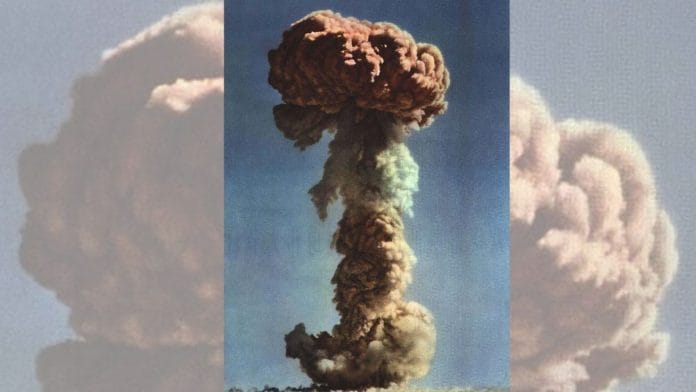In an era of multiple strifes across continents, an anniversary quietly slipped under the radar of world watchers. Eighty years ago, an explosion ushered in a new age of combat, weapons, tactics, and technology. At 5:29 am local time on 16 July 1945, the United States tested the world’s first atomic bomb in the desolate desert of New Mexico in an area called Jornada del Muerto—Spanish for “Dead Man’s Road”.
The site couldn’t have been chosen because of the irony in its name. In the days of Spanish expansion into the New World, this must have certainly been a deadly route to take, but that was centuries before America’s wartime quest for the world’s most potent weapon. And it was tested under the codename ‘Trinity’. A multi-billion-dollar initiative that involved scores of enterprises, institutions, and scientists of various disciplines working under strict military supervision, it was innocently labelled ‘Manhattan Project’.
Innocent, since the name didn’t convey its unifocal military purpose. The world entered the nuclear age with a military purpose, and its impact on 6 and 9 August 1945 over Hiroshima and Nagasaki are historical landmarks that will not be erased anytime soon. Reams have been written about the Manhattan Project and its impact. The ghastly use of the bomb against Japan has also been dissected threadbare. What has been relegated to dusty shelves and nerdy researchers, however, is the official report on the programme. It’s unambiguously called Atomic Energy for Military Purposes.
Among the most extraordinary aspects of the report is that it was made public on 12 August 1945, even before the radioactive clouds had lifted from Hiroshima and Nagasaki. Princeton University physicist Henry DeWolf Smyth penned the report. Within the community that contributed to making the nuclear fission device a success, the Smyth Report was the working paper on how the Manhattan Project was to be discussed. It is patently clear that the US was working on a long-term nuclear perspective.
Also read: What India can learn from Israel about atmanirbharta in defence
India’s nuclear age
The American military approach is a far cry from how India viewed the arrival of the nuclear era. Although its nuclear journey is extraordinary among formerly colonised nations, India missed vital landmarks along the way.
In July 1945, India already had a nuclear research programme at the Tata Institute of Fundamental Research (TIFR), established months before Washington’s Trinity test. Within a year of Independence, the country also had an Atomic Energy Commission, and in less than a decade, it had commissioned Asia’s first nuclear reactor, APSARA, at Trombay. India was light years ahead of any other Asian country.
In the 1950s, China was largely dependent on its larger ideological ally, the Soviet Union. It entered the nuclear age with a sole purpose, based on Chairman Mao’s dictum, “Power flows from the barrel of a gun.” The simple formulation offered Beijing both short-term benefits and dividends in the long run, too. It is now obvious that the possession of weapons of mass destruction will not invite military intervention in an era of mass hypocrisy. Iran and Iraq, which didn’t possess nuclear arsenals, were attacked, while North Korea, which did, wasn’t. Hypocrisy and discrimination are obviously kosher in today’s world order.
India, however, approached the nuclear era from the perspective of “peaceful utilisation” to harness unlimited energy and enter the club of rapidly developing countries. It officially launched a three-stage nuclear programme with an indigenous research and development project. But eight decades after TIFR initiated its research programme, India remains light years away from its early energy vision. And it has also missed the bus to power by failing to test a bomb on time.
Even as it was obvious that the world was entering a discriminatory nuclear regime that no amount of third-worldism or non-alignment mantras could prevent, India persisted in keeping company with those who had nothing to lose.
China, on the other hand, tested its first device in 1964, as soon as it could put the nuclear bolts together. It joined the nuclear club and subsequently became a permanent member of the United Nations Security Council. By the time India tested the bomb in 1974, the doors of the nuclear elite club had closed.
Manvendra Singh is a BJP leader, Editor-in-Chief of Defence & Security Alert, and Chairman, Soldier Welfare Advisory Committee, Rajasthan. He tweets @ManvendraJasol. Views are personal.
(Edited by Prasanna Bachchhav)






